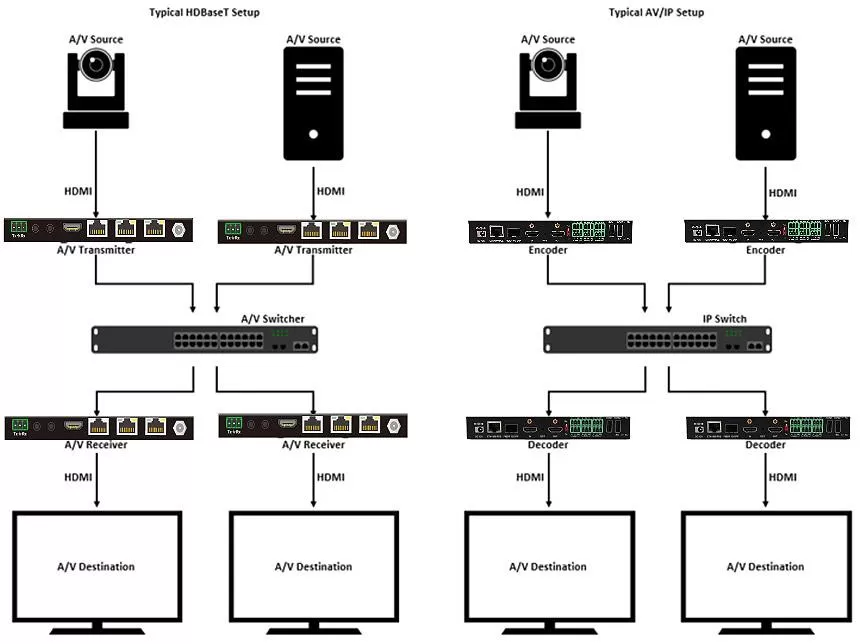IP over AV is booming
IP-based AV has appeared in the audio and video industry as early as, but it has been particularly popular in the past three years. In 2017 and 2018, IP video and audio products grew by nearly 130% for two consecutive years, attracting all audio and video professionals. IP over AV has become the most eye-catching focus in every major professional exhibition including ISE and InfoComm. Some professionals in the audio and video industry pointed out bluntly that IP audio and video have become the future trend of the audio and video industry. It is expected that from 2019 to 2025, its compound annual growth rate will reach an astonishing 60%.
What is the difference between traditional A/V and AV over IP?
The traditional A/V architecture is similar to the basic elements and main architecture of the IP over AV architecture. From a simple architecture diagram, AV on IP uses an encoder to replace the traditional A/V transmitter (Tx), and a decoder to replace the signal receiver (Rx). The audio and video matrix switcher has been replaced by a standard Ethernet IP switcher. IP switches are the same as those commonly used in every enterprise. As long as your organization has an IT infrastructure, it must have at least one IP switcher.
In IP AV, the structure, although the two architects look very similar, has two important differences:
Transmission: No matter how the system is connected, no matter what kind of signal and analog signal (such as S-Video or composite signal) or digital signal (such as HDMI, HDBaseT, SDI, etc.), traditional AV uses "physical cables" to transmit video signals Transmission via cable and matrix switcher. On the other hand, IP-based AV uses conventional cables (such as Cat5e or Cat6) to connect to the IP switch and transmit via Ethernet, WAN, LAN or WiFi.
Data format: Traditional A/V does not require any data compression, splitting or encoding to keep the data from the AV source intact, and then transmit the data to the AV destination through a series of physical cables and switch boxes. On the contrary, in the AV over IP architecture, the data of the AV source is encoded into network data packets by the encoder, and each data packet contains a part of the original data, the target IP and the original data sequence. The IP switcher sends the data packet to the target decoder, and then decodes and reassembles the data packet into a data format acceptable to the AV target for display or control functions.
Switching method: In traditional A/V, the matrix switcher plays an important role in transmitting the signal from the signal source to the designated target. Except for some extended models, most matrix switchers have a fixed number of ports, which are distinguished by input and output ports. Generally, matrix switchers are hardware-based point-to-point technology. Common products include 4×4, 8×8, 16×16, or 64×64 matrix switchers. Take a 4×4 (4 inputs and 4 outputs) matrix switcher as an example, which can transmit 4CH AV source signals and switch to 4 arbitrary destination devices for display, playback or control. The difference is that the switching mode of AV over IP is to provide an IP address for all endpoints and broadcast the IP switcher broadcast data packet to the destination. The switch path is performed by specifying the source and destination IP addresses defined by the software. Since the port of the IP switcher can be connected to multiple IP switches for expansion, the number of source and destination endpoint devices is no longer limited by the number of matrix switcher ports. Most importantly, the number of endpoint devices can be It is arbitrarily expanded and adjusted.
Click NP Pro to learn more AV OVER IP product information.




